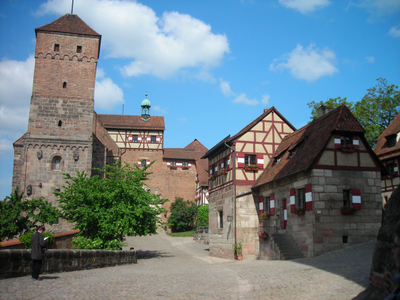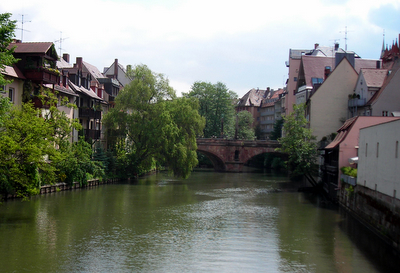With over a thousand years of recorded history, Nürnberg ( Nuremberg) has a varied past. From a trade center in the medieval Holy Roman Empire and cultural hub in the German Renaissance to host city of Nazi party rallies in the 1930s and the ensuing War Trials in the 1940s, Nürnberg has many stories to tell. Today, the largest city in the Franconia region is as  busy as ever, constantly redefining itself while always presenting a classic view of Germany.
busy as ever, constantly redefining itself while always presenting a classic view of Germany.
Franconia is often viewed by southern Bavarians as a cultural backwater inhabited by farmers and simpletons. Stepping within the ancient walls of Nürnberg, one immediately sees the fallacy in that characterization. After Allied bombings in 1945 ruined nearly ninety percent of the original city, Nürnberg has been rebuilt to its former grandeur. In the Hauptmakt, or Main Market, stalls sell locally grown foods from cherries to asparagus. Medieval churches have been restored and the many cobblestone streets have been replaced.
 Less well known outside of Germany is the role Nürnberg played in the growth of the National Socialist German Workers’ Party, better known as the Nazi Party. Long before the rise of Adolf Hitler, Nürnberg hosted rallies and parades to unify the region for the Workers’ Party. After seizing control of both the party and the country, Hitler used Nürnberg’s tradition of supporting the party to his advantage. Constructing an enormous rally ground in the southeast part of the city, Hitler’s Nazis paraded, gave speeches and terrified the world. Many of the most famous images of storm troopers and massive crowds come from these rallies in Nürnberg.
Less well known outside of Germany is the role Nürnberg played in the growth of the National Socialist German Workers’ Party, better known as the Nazi Party. Long before the rise of Adolf Hitler, Nürnberg hosted rallies and parades to unify the region for the Workers’ Party. After seizing control of both the party and the country, Hitler used Nürnberg’s tradition of supporting the party to his advantage. Constructing an enormous rally ground in the southeast part of the city, Hitler’s Nazis paraded, gave speeches and terrified the world. Many of the most famous images of storm troopers and massive crowds come from these rallies in Nürnberg.
Today, Hitler’s Kongresshall has been transformed from a testament to the power of the Nazis to a surprisingly objective museum. The DokuZentrum, or Documentation Center, shares the city’s sometimes-dark past and allows its visitors to come to their own conclusions about the responsibility of Nürnberg in the rise and fall of Nazism.
 Of course not all of Nürnberg is focused on the Nazis. Hundreds of years earlier, one of the world’s most famous artists perfected his craft in the city. Albrecht Dürer, a 16th century artist from Nürnberg spent his days painting, printing and creating woodcuts. A museum is located in Dürer’s former house and statues of his likeness and most famous works dot the city.
Of course not all of Nürnberg is focused on the Nazis. Hundreds of years earlier, one of the world’s most famous artists perfected his craft in the city. Albrecht Dürer, a 16th century artist from Nürnberg spent his days painting, printing and creating woodcuts. A museum is located in Dürer’s former house and statues of his likeness and most famous works dot the city.
No description of Nürnberg’s cultural importance would be complete without mention of its specific type of bratwurst. Known as a Nürnberger Bratwürst, the sausage is rolled thinner and shorter than traditional brats. Nürnberg’s residents swear by the supremacy of their Nürnbergers, though they eat them more as a snack than a sit-down meal. But when ordering these brats for yourself, be sure to ask for ‘drei im weckla,’ or  three-in-a-roll. Only tourists order Nürnbergers in numbers that are not multiples of three.
three-in-a-roll. Only tourists order Nürnbergers in numbers that are not multiples of three.
While Munich gathers most of the attention of travelers to Bavaria, Nürnberg has become somewhat of a hidden treasure. With public transportation readily available and innumerable churches, museums, markets and food choices, Nürnberg is well worth a visit.
Written by Michael Orr for EuropeUpClose.com

Germany Christmas Markets: a World of Christmas Magic
Friday 24th of October 2014
[…] Nuremburg The Christmas Angel opens Nuremberg’s ever-popular Christkindlesmarkt on Hauptmarkt square. Enjoy the medieval atmosphere and delicious aromas of gingerbread, bratwurst, roasted almonds and glühwein. The children’s market has a traditional carousel, Ferris wheel and steam train. Between the two markets is the Nativity trail, taking visitors on a tour of the city’s many Nativity scenes. […]